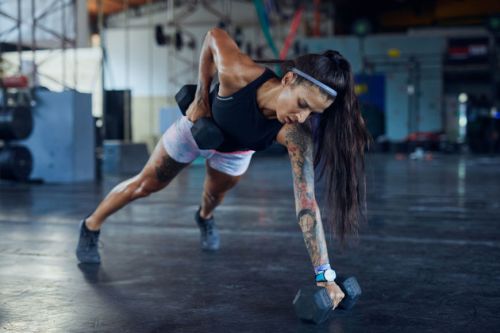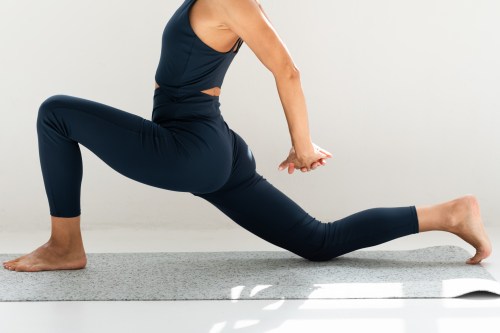Different workout classes are scary for different reasons. Yoga’s intimidating because it can easily make you fart in public (sorry, but it’s true). I’m always afraid to clip into a spin bike because I don’t know how to clip back out. And if I rewind it back to before I started doing HIIT, I’ve gotta admit that the fast-paced intensity of boot camps and other high intensity interval training workouts was very, very intimidating.
HIIT workouts are enticing for a lot of reasons—they’re short, they’re effective, and you can do them anywhere without equipment. So it pays off to eat that frog and at least give HIIT a whirl for the sake of sweat. HIIT workouts push you hard. “They bring your body to the point of exhaustion since they alternate between intense anaerobic periods followed by less intense, but working recovery periods, and on and on,” says Branko Teodorovic, FlexIt master trainer.
But, not everyone’s at the same fitness level—so how do you ensure that you nail your first high intensity sweat sesh? “Intensity is different for everyone, so my HIIT workout as an advanced athlete will be completely different from someone who’s just starting out,” says Evan James Betts, founding trainer of GRIT BXNG. He also points out that HIIT doesn’t necessarily equate to complex movements, so you could still be doing basic exercises like squat jumps or tuck jumps to get a great workout.
So that you feel the absolute most confident strolling into that yet-to-be explored HIIT class (or even if you’re trying it at home), here are six insider tips for conquering it—no sweat (figuratively speaking, of course).
1. Warm up properly
Stretching and warming up before any workout is pretty much standard protocol, but it’s especially key before HIIT because of how high-impact the workout can be. You’re using your body to its potential, so you want to make sure your muscles are prepped for that. Selena Samuela, a Peloton Tread instructor, says it’s the most important thing you can do. Try a dynamic warm up, which will gently get your heart rate up while moving your muscles before they go full speed ahead.
2. Hydrate
It seems like a no brainer, but trainers agree that it’s essential to drink enough water before you start sweating. “Make sure that you’re properly hydrated before coming to the class,” says Teodorovic. “Constantly hydrate during class, too—your muscles can’t perform without electrolytes, so make sure you have plenty.” I like Nuun Hydration Sport Tablets ($6) to refuel.
3. Fuel properly
Besides being very well hydrated, Teodorovic advises to load up on the proper nutrients before you workout so that your body has energy to burn. “Think about a car: It won’t run at all without gasoline, and it’s the same with your body without proper nutrients,” he says. “Oats are a great source of energy in the morning, and faster acting carbs in the afternoon, like white rice or rice cakes, properly store glycogen in your muscles so that they’re ready to perform.” Don’t go on an empty stomach.
3. Keep it simple
I’m not going to lie to you: HIIT workouts are hard. There’s no shortcutting that. But! Betts highly recommends to stick to the K.I.S.S. (keep it simple, Sally) method when you’re new to them. “HIIT doesn’t mean complex, so [if you’re doing HIIT on your own] choose a designated amount of time or reps you want to complete for each exercise, complete all exercises back to back with no rest in between, take a short rest once they’re all completed, then repeat.” His example of a starter HIIT workout includes 20 squat jumps, 20 knee-tuck jumps, 10 burpees, 40 mountain climbers, then rest for 60 to 90 seconds before repeating five times.
4. Don’t go too hard
I mean, you’re going to do a hard workout and your body will be pushed… but trainers say to not, ya know, cross the line and push yourself beyond your physical limits. “One obstacle you will face every time you engage in HIIT training is a spike in your heart rate and lactic acid fatigue,” says Betts. “This is completely normal, but may intimidate first timers. Gauge what your body is capable of handling, and push your limits when you can.” Chris Gronkowski, FlexIt master trainer and founder and CEO of Ice Shaker, agrees, noting that if you’re not used to HIIT, don’t go all out on your first set. “You want to be at a point where you’re able to get your heart rate up close to its max, but also to a point where it’s able to come back down, and you can recover during the rest period,” he says.
5. Modify when you need to
Typically, instructors will give out modifications to moves that can seem advanced, so it’s helpful to try them out when you’re new. “The instructors should be showing modifications, and it’s really important,” says Stacey Vandiver, master trainer at FlexIt and CEO of SoulBody Fitness. “Every exercise carries modification capability. Be mindful of your limits, and make your fitness work for you.”
6. Rest and recover
Resting is the key to being healthy in life, and every other workout, and the same goes for HIIT training. Don’t go from zero to 100. “Allow your muscles to properly recover,” says Teodorovic. “Have plenty of rest time between HIIT sessions. Without being fully rested, you can’t perform at the optimal level.”
Now, you can start by trying this at-home HIIT workout that only takes six minutes. Also helpful? These expert-backed recovery tips for HIIT workouts.
Sign Up for Our Daily Newsletter
Get all the latest in wellness, trends, food, fitness, beauty, and more delivered right to your inbox.
Got it, you've been added to our email list.











